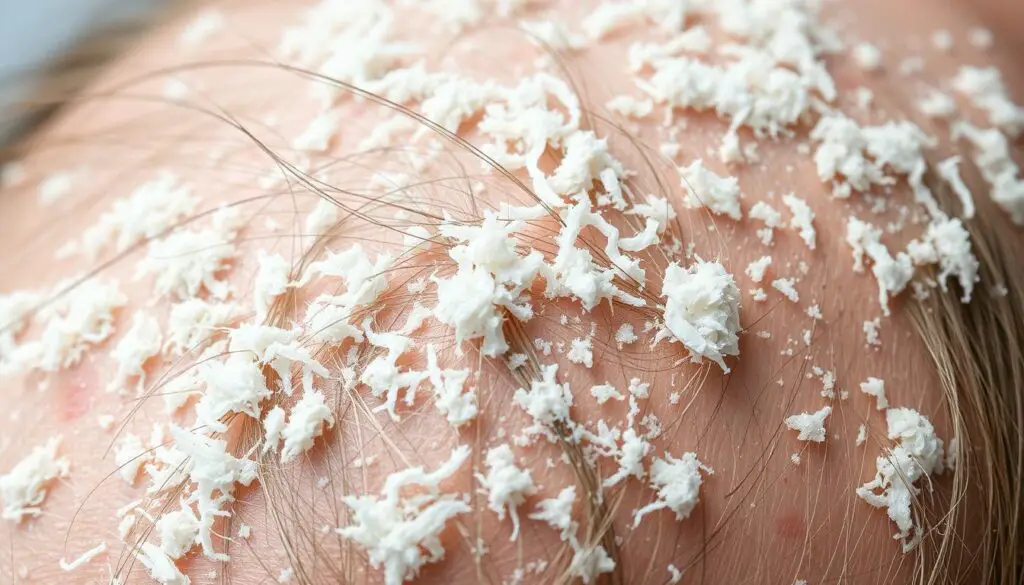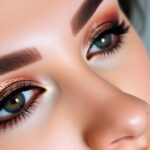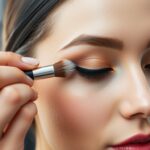What Is Dandruff? Ever felt embarrassed when white flakes show up on your dark shirt? You’re not alone in this feeling. Dandruff is a common scalp problem that many people face.
About 50% of adults deal with dandruff. It happens when your scalp sheds skin cells too fast, usually in 2 to 7 days. Men are more likely to get it because of hormones that make their scalp oilier.
Knowing what causes dandruff can help you fight it. The main reason is often a fungus called Malassezia. It feeds on scalp oils and makes skin cells fall off quickly. People with oily skin and those under stress are more prone to it.
Dandruff might seem like a small problem, but it can really affect your confidence. The bright side is that up to 80% of cases can be managed with the right care and treatments.
Table of Contents
Understanding Dandruff: An Overview
Dandruff is a common scalp condition that affects millions of people worldwide. About 50% of adults deal with flaky scalp issues at some point. Knowing what dandruff is is key to managing it well.
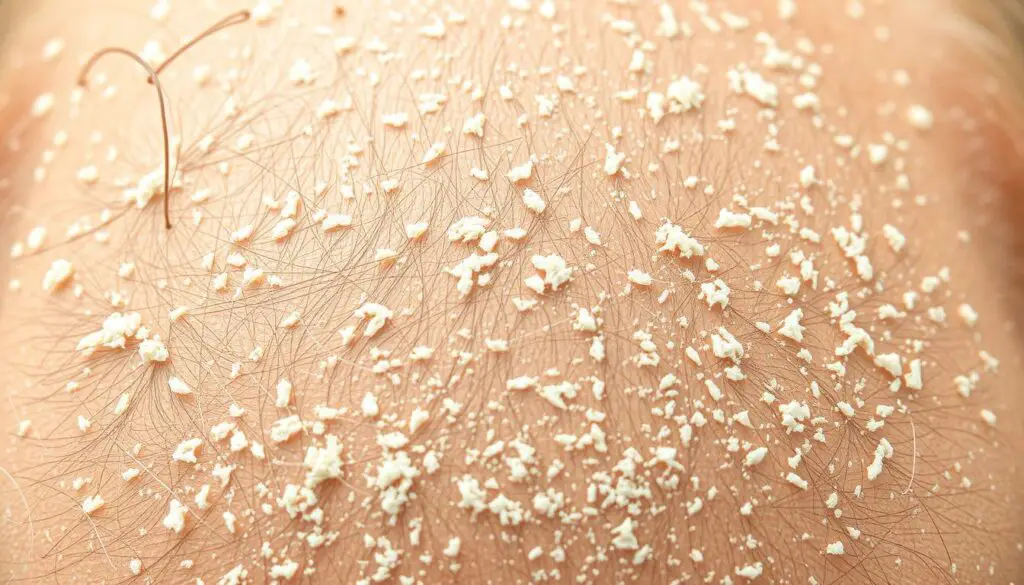
Understanding dandruff means seeing it as more than just dry skin. It involves complex interactions between your scalp’s natural processes and external factors.
Definition of Dandruff
Dandruff is marked by white or yellowish skin flakes that fall off the scalp. It has several key characteristics:
- Larger, oily flakes compared to normal dry scalp skin
- Potential scalp itching
- Possible redness or irritation
“Dandruff is not just about appearances, but about understanding your scalp’s health.”
Common Misconceptions
Many people think dandruff is just a hygiene issue. But research shows several important facts:
- Dandruff usually starts after puberty
- Men are more likely to get dandruff because of oilier skin
- An overgrowth of Malassezia yeast plays a big role in the condition
Knowing these facts helps you tackle dandruff better. It shows it’s a complex scalp condition, not just a cleanliness problem.
The Causes of Dandruff
Dandruff is a complex scalp condition with many causes. Knowing what causes dandruff helps you manage and treat it. Many people get dandruff, but the reasons differ.

Fungal Infections and Yeast Overgrowth
Malassezia yeast, which is on everyone’s scalp, can cause dandruff. When it grows too much, it makes skin cells fall off. Men are more likely to get this because their skin is oilier.
- Malassezia feeds on skin oils
- Increases skin cell renewal rate
- More common in individuals with oily scalp
Dry Skin and Scalp Conditions
A dry scalp can lead to dandruff. Cold, dry weather makes it worse, causing more irritation and flaking. Keeping your scalp moist helps prevent dandruff.
Oily Scalp and Hormonal Influences
Too much oil on your scalp can cause dandruff. Hormonal changes, especially in androgen levels, can make your scalp oilier and lead to dandruff.
| Risk Factor | Impact on Dandruff |
|---|---|
| Hormonal Changes | Increases oil production |
| Skin Conditions | Heightens inflammation |
| Weather | Triggers dry scalp |
Additional Skin Conditions
Conditions like eczema and psoriasis can make you more likely to get dandruff. They cause more irritation and change how much oil your scalp makes, perfect for dandruff.
“Understanding your scalp’s unique characteristics is key to managing dandruff effectively.” – Dermatology Insights
Managing dandruff means looking at both outside factors and your skin’s special needs.
Symptoms You Might Experience
Dandruff is a common problem that affects many people. Knowing the symptoms helps you tackle it effectively.
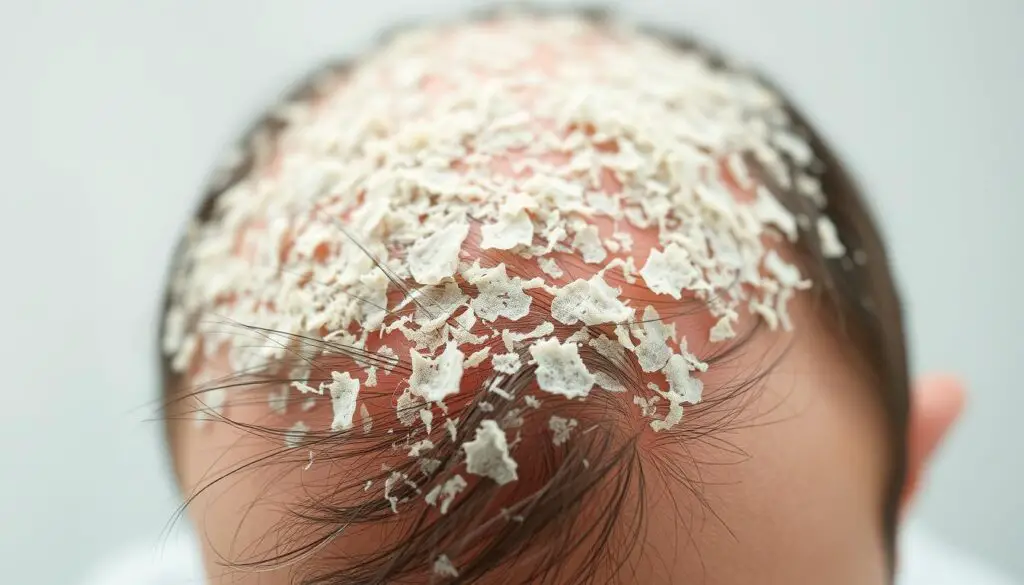
Visible Flakes: What to Look For
Visible flakes in your hair and on your shoulders are a key sign of dandruff. These flakes can be small white particles or larger yellow-tinged scales. An itchy scalp makes these flakes more noticeable, especially in dry winter months.
- White or yellowish skin flakes
- Flakes visible on clothing
- Increased flaking during colder seasons
Itching and Irritation: Understanding the Discomfort
An itchy scalp is a clear sign of dandruff. The urge to scratch can be annoying and may irritate your scalp more. Finding the right treatment can ease this discomfort.
“An itchy scalp can significantly impact your daily comfort and confidence.”
Redness and Inflammation: Warning Signs
Severe dandruff can also cause scalp redness and inflammation. These signs might mean you need to see a doctor for a more serious issue.
| Symptom Type | Characteristics | Potential Cause |
|---|---|---|
| Mild Flaking | Small white flakes | Dry skin |
| Persistent Itching | Constant scalp irritation | Fungal growth |
| Scalp Inflammation | Red, sensitive areas | Seborrheic dermatitis |
About 50% of adults deal with dandruff at some time. If your symptoms don’t get better or get worse, see a doctor for help.
How Dandruff Affects Your Life
Dealing with a flaky scalp is more than just a physical issue. Dandruff affects your life in many ways, touching on social and emotional aspects. It goes beyond simple skin irritation.

Social Challenges of Dandruff
Living with dandruff can make social situations uncomfortable. About 50% of adults worldwide deal with this issue. But, it doesn’t make it any easier to handle.
White or yellow flakes on your shoulders can make you feel self-conscious. This can happen during conversations or professional meetings.
- Feeling embarrassed in social settings
- Worrying about visible scalp health issues
- Potential reduction in self-confidence
Emotional Toll of Scalp Health Struggles
The emotional impact of persistent dandruff is significant. Constant itching and visible flakes can lead to increased stress and anxiety. This can create a cycle that worsens scalp conditions.
“Your scalp health is more than just a physical concern – it’s deeply connected to your emotional well-being.”
Research shows that stress can make dandruff symptoms worse. It’s important to tackle both the physical and psychological sides of this condition. By understanding these challenges, you can find ways to manage your scalp health and keep your confidence up.
Diagnosing Dandruff
Understanding dandruff starts with knowing its signs and when to see a doctor. Diagnosing it involves watching for symptoms and sometimes getting expert advice.
Spotting dandruff is easy for many, but some need a closer look. The process usually includes two steps: talking to a doctor and checking yourself at home.
Professional Consultations
Even though most dandruff doesn’t need a doctor, a dermatologist can help a lot. Here’s what you can expect:
- Detailed scalp examination
- Review of medical history
- Assessment of potential underlying conditions
- Scalp skin sample analysis if necessary
At-Home Tests
To treat dandruff well, you can do some simple checks at home:
- Check for persistent white or yellow flakes
- Monitor scalp itchiness and irritation
- Observe scalp condition after washing
- Track changes in flake size and frequency
“Early detection and consistent care are key to managing dandruff effectively.” – Dermatology Experts
| Diagnostic Indicator | Home Assessment | Professional Evaluation |
|---|---|---|
| Flake Characteristics | Visual inspection | Microscopic analysis |
| Scalp Condition | Personal observation | Comprehensive examination |
| Underlying Causes | Limited understanding | Detailed medical investigation |
Remember, if symptoms last or get worse, see a doctor to check for other scalp problems.
Treatment Options for Dandruff
Dealing with dandruff can be frustrating, but there are many effective treatments. You can find over-the-counter solutions and prescription treatments. These options help fight off those annoying white flakes.
Over-the-Counter Dandruff Shampoos
Dandruff shampoo is a quick fix for most people. Look for shampoos with:
- Pyrithione zinc
- Selenium sulfide
- Ketoconazole
- Salicylic acid
- Coal tar
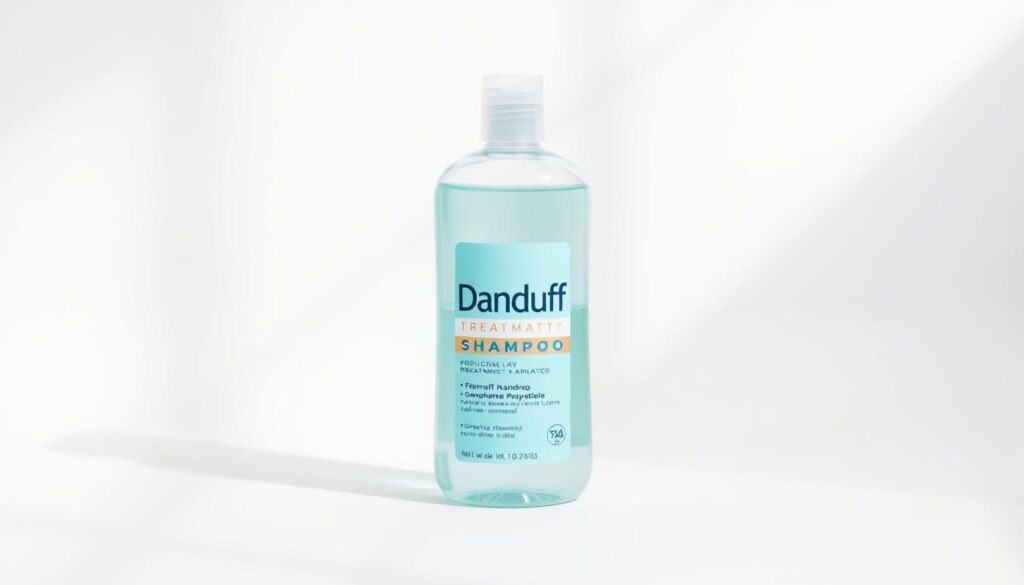
Prescription Treatments
If your dandruff is severe, your doctor might suggest stronger treatments. These include antifungal medications or medicated shampoos not found in stores.
Home Remedies
Natural treatments can also help:
- Tea tree oil scalp treatments
- Apple cider vinegar rinses
- Coconut oil scalp massages
- Aloe vera applications
“Consistency is key when treating dandruff. Most treatments require 2-3 weeks of regular use to show significant improvement.”
Remember, what works for one person might not work for another. If your symptoms don’t get better or get worse, talk to a healthcare professional.
Choosing the Right Shampoo
Finding the right dandruff shampoo can really help your scalp. There are many choices out there. Knowing what to look for is important to fight off those white flakes.

Understanding dandruff shampoos means knowing about key ingredients. These ingredients help your scalp in different ways. It’s important to pick a shampoo that meets your specific needs.
Essential Ingredients to Seek Out
- Zinc Pyrithione: Fights fungal growth and reduces dandruff
- Salicylic Acid: Helps remove dead skin cells
- Ketoconazole: Powerful antifungal agent
- Tea Tree Oil: Natural solution for scalp irritation
Ingredients to Sidestep
- Harsh sulfates that strip natural oils
- Alcohol-based products that dry out scalp
- Artificial fragrances causing irritation
- Parabens and silicones
When looking for a dandruff shampoo, think about your scalp and hair. Some shampoos are better for oily scalps, while others are good for dry or sensitive skin.
| Shampoo Type | Price Range | Key Active Ingredient |
|---|---|---|
| Hairitage Wash It Away | $10 | Zinc Pyrithione |
| Oribe Serene Scalp | $166 | Salicylic Acid |
| Jupiter Balancing | $35 | Tea Tree Oil |
Pro tip: Rotate between two different dandruff shampoos to prevent product resistance and maintain optimal scalp health.
Consistency is key. Most dandruff shampoos suggest using them 2-3 times a week. If your symptoms don’t get better, see a dermatologist for advice.
Lifestyle Changes for Dandruff Prevention
Managing scalp health is more than just washing your hair. It’s about understanding how your daily habits affect your scalp. About 50% of people deal with dandruff at some point. So, making lifestyle changes is key to preventing it.
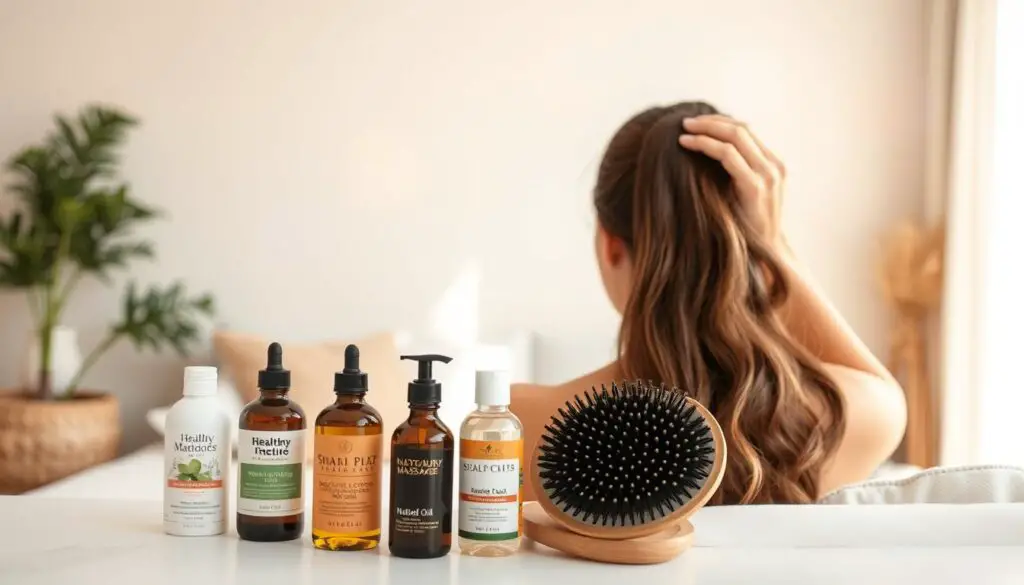
Your lifestyle greatly affects dandruff and scalp health. Making smart changes can cut down on flaking and irritation. This improves your scalp’s overall condition.
Diet and Nutrition Strategies
Your diet impacts your scalp health. Some foods can make dandruff worse:
- Reduce high sugar intake, which can feed bacteria causing scalp issues
- Limit full-fat dairy products known to trigger scalp inflammation
- Increase zinc and vitamin B intake for healthier scalp conditions
Stress Management Techniques
Stress can make dandruff symptoms worse by up to 50%. Try these stress-reduction tips:
- Practice daily meditation
- Engage in regular exercise
- Maintain consistent sleep patterns
Developing a Consistent Scalp Care Routine
A regular scalp care routine is vital for dandruff treatment. The American Academy of Dermatology suggests using anti-dandruff shampoo for 2 to 3 weeks to see results.
“Your scalp is a reflection of your overall health. Treat it with care and attention.” – Dermatology Expert
By making these lifestyle changes, you can manage dandruff and improve scalp health. Remember, being consistent is crucial for lasting results.
Natural Remedies for Dandruff
Dealing with dandruff doesn’t need to be expensive. Natural remedies can be just as effective. They help treat dry scalp issues without harsh chemicals.

Essential Oils for Scalp Health
Essential oils are great for fighting dandruff and soothing a dry scalp. Some oils are especially good for scalp health:
- Tea tree oil: Shows strong antifungal properties
- Lavender oil: Helps reduce scalp inflammation
- Peppermint oil: Boosts circulation and aids in healing
Aloe Vera: Nature’s Scalp Soother
Aloe vera is amazing for your scalp. It has anti-inflammatory properties that calm irritation and lessen flaking. Applying pure aloe vera gel for 20-30 minutes can greatly improve your scalp’s condition.
“Natural remedies can be powerful allies in managing scalp health and reducing dandruff.” – Dermatology Research Institute
Apple Cider Vinegar Treatment
Apple cider vinegar is a strong natural treatment for dandruff. Its acidity helps balance your scalp’s pH and fights fungal growth. For best results, apply it for 15-20 minutes.
| Natural Remedy | Key Benefits | Application Time |
|---|---|---|
| Tea Tree Oil | Antifungal properties | 15-20 minutes |
| Aloe Vera | Reduces inflammation | 20-30 minutes |
| Apple Cider Vinegar | Balances scalp pH | 15-20 minutes |
Natural remedies can work well, but if dandruff is severe, see a doctor. Always test new treatments first and talk to a dermatologist if problems don’t go away.
Medical Conditions Linked to Dandruff
Your scalp can face many medical issues that look like dandruff but need special care. Knowing these conditions helps you take better care of your scalp.
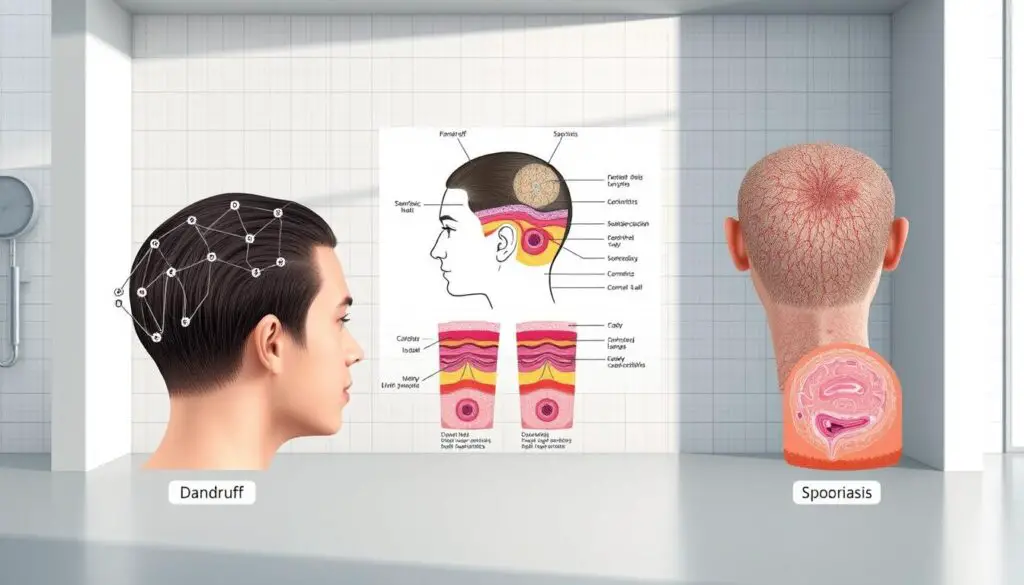
Seborrheic dermatitis is more than just dandruff. It’s a skin condition that affects 3% to 5% of people worldwide. It makes scalp care a big challenge.
Psoriasis: More Than Just Flakes
Psoriasis shows up as thick, red patches with silvery scales on the scalp. It’s different from dandruff because it makes skin cells grow too fast. This leads to scaling and itching.
- Characterized by raised, inflamed patches
- Genetic predisposition plays a significant role
- Can cause significant scalp discomfort
Eczema: Persistent Scalp Irritation
Eczema causes intense skin inflammation that hurts your scalp. It makes the skin dry, red, and itchy. These symptoms are worse than dandruff.
Seborrheic Dermatitis: A Complex Condition
Seborrheic dermatitis is a skin disorder related to dandruff. It usually hits people between 30 and 60 years old. It makes the scalp greasy and yellowish.
| Condition | Key Characteristics | Prevalence |
|---|---|---|
| Psoriasis | Thick red patches, silvery scales | 2-3% of population |
| Eczema | Intense inflammation, extreme dryness | 10-20% of adults |
| Seborrheic Dermatitis | Greasy, yellowish scales | 3-5% of global population |
“Understanding your specific scalp condition is the first step toward effective treatment.” – Dermatology Research Institute
Seeing a doctor is key for the right diagnosis and treatment of these scalp issues.
Myths About Dandruff
Dandruff is a common scalp issue with many myths. Knowing what dandruff is and its causes can help you deal with it better.
Many think dandruff comes from being dirty. This is a dangerous myth. But, dandruff’s causes are more complex, involving many factors beyond just being clean.
Debunking the Hygiene Myth
It’s not true that dandruff is caused by not washing your hair enough. It can happen to anyone, no matter how clean they are. The real causes include:
- Skin cell turnover rate
- Fungal presence on the scalp
- Individual skin sensitivity
- Hormonal changes
Scalp Type Misconceptions
Many believe dandruff only happens on oily scalps.
“Dandruff doesn’t discriminate between dry and oily scalp types”
But, research shows it can affect both dry and oily scalps.
Here are some interesting facts about dandruff:
- More than 50% of adults worldwide have dandruff.
- Males are more likely to get dandruff.
- Only 10% of people get professional help for it.
Knowing these myths can help you tackle dandruff with the right information. It boosts your confidence in taking care of your scalp.
Seasonal Variations of Dandruff
Dandruff changes with the seasons. Your scalp goes through big changes each year, affecting dry scalp and dandruff. Knowing these changes can help you take better care of your scalp.
Seasonal changes cause different dandruff problems. Your scalp reacts differently to temperature and humidity changes. This leads to unique patterns of flaking and irritation.
Winter Dandruff Dynamics
Winter is tough on your scalp. The dry air and heating indoors take away your scalp’s natural moisture. This makes dandruff worse. Studies show dandruff cases go up by 50% in fall and winter.
- Cold temperatures reduce scalp moisture by 20-30%
- Indoor heating further depletes natural scalp oils
- Dry air increases skin cell turnover and flaking
Summer Scalp Conditions
Summer brings its own dandruff challenges. The humidity and sweat make it easier for fungus to grow. Also, styling products can cause about 30% of scalp irritation.
- Heat triggers increased oil production
- Humid conditions promote fungal growth
- Sweat can accumulate scalp debris
“Your scalp is a dynamic ecosystem, constantly responding to environmental changes.” – Dermatology Research Institute
Managing Seasonal Scalp Health
There are ways to fight seasonal dandruff. Adjust your hair care to fit the weather. Using special treatments and keeping your scalp moist can cut dandruff by up to 40%.
- Use sulfate-free shampoos
- Employ humidifiers to retain scalp moisture
- Perform regular scalp massages
Understanding Scalp Health
Your scalp is more than just the base for your hair. It’s a complex system that affects your hair and skin health. Keeping your scalp healthy can stop problems like a flaky scalp and make your hair look and feel great.
Scalp health means knowing the balance of tiny living things and outside factors that affect your hair. About 90% of your hair follicles are always making hair. So, taking care of your scalp is key for beautiful, strong hair.
Importance of a Healthy Scalp
A healthy scalp helps your hair grow strong and prevents issues like dandruff and irritation. Key parts of scalp health include:
- Balanced moisture levels
- Proper nutrient circulation
- Controlled microbiome environment
- Minimal inflammation
Scalp Exfoliation Techniques
Exfoliating your scalp gets rid of dead skin cells and stops buildup that causes flaky scalp problems. Here are some good ways to do it:
- Gentle chemical exfoliation with salicylic acid
- Physical scalp scrubs
- Brush massage techniques
| Exfoliation Method | Frequency | Benefits |
|---|---|---|
| Chemical Exfoliant | 1-2 times per week | Removes dead skin cells, unclogs follicles |
| Physical Scrub | Every 2 weeks | Stimulates circulation, removes buildup |
| Scalp Massage | 3-4 times per week | Promotes blood flow, reduces stress |
“A healthy scalp is the foundation of beautiful, strong hair.” – Dermatology Experts
Remember, everyone’s scalp is different. Listen to what your scalp needs and see a pro if you have ongoing scalp problems or strange symptoms.
Dandruff and Hair Loss: What to Know
Scalp health is key to having healthy hair. Knowing how dandruff and hair loss are connected can help keep your hair strong. Dandruff is more than just a nuisance; it can harm your hair’s health and growth.
Research shows some surprising facts about dandruff and hair loss. People with ongoing dandruff might lose more hair than usual.
Is There a Connection?
The link between dandruff and hair loss is complex. Studies show that long-term scalp inflammation can weaken hair follicles. This might cause hair to thin.
- Fungal overgrowth (Malassezia) is found in 90% of dandruff cases
- Chronic scalp inflammation affects up to 20% of people
- Those with dandruff might lose 100-300 hairs every two days
Preventing Hair Loss
To keep your scalp healthy, you need to act early. Here are ways to reduce hair loss while fighting dandruff:
- Use anti-dandruff shampoos specifically designed for the problem
- Stick to a regular hair care routine
- Keep stress levels in check
- Eat right to support your hair
*”Your scalp is the foundation of healthy hair growth”* – Dermatology Experts
Understanding the link between dandruff and hair loss lets you take charge of your scalp health. While not all dandruff causes hair loss, treating the root causes can greatly improve your hair’s health.
When to Seek Professional Help
Dandruff is more than just a skin issue. Knowing when to get medical help is key for your scalp’s health. If your dandruff doesn’t get better after a month of trying to fix it yourself, up to 70% of people might need a dermatologist’s help.
Recognizing Persistent Symptoms
Keeping an eye on your scalp is important. Look out for these signs that mean it’s time to see a doctor:
- Severe scalp inflammation or redness
- Intense itching that doesn’t subside
- Large, thick, or yellowish flakes
- Signs of seborrheic dermatitis
- Scalp pain or tenderness
Additional Skin Concerns
Some skin problems can look like dandruff or make it worse. A dermatologist can figure out what’s going on and help:
| Condition | Key Characteristics | Professional Intervention |
|---|---|---|
| Seborrheic Dermatitis | Greasy, yellow-red patches | Prescription topical treatments |
| Scalp Psoriasis | Silver-white scales, thick plaques | Specialized skin therapy |
| Fungal Infections | Persistent scaling, intense itching | Antifungal medications |
Dermatologists can give you specific plans to treat your dandruff. They can find and fix the real cause of your scalp problem. If your symptoms keep getting worse, don’t wait to get expert advice.
“Early intervention can prevent long-term scalp health complications” – Dermatology Research Institute
Preventative Measures You Can Take
To keep your scalp healthy, you need to take steps to prevent dandruff. Your daily hair care routine is key. It helps keep your scalp clean and balanced, avoiding irritation.
Essential Hair Care Techniques
Creating a good dandruff treatment plan involves several important steps:
- Wash your hair regularly with anti-dandruff shampoos
- Use shampoos with 2% ketoconazole or selenium sulfide
- Switch between regular and medicated shampoos for scalp health
- Do gentle scalp massages to boost blood flow
Optimal Washing Frequency
Dermatologists suggest a specific washing schedule based on your scalp’s needs. For dandruff, start by washing three times a week. As your scalp gets better, you can wash once a week.
“Regular washing is crucial for regulating sebum levels and removing dead skin cell buildup” – Dermatology Experts
Additional Preventative Strategies
There are more ways to prevent dandruff:
- Use a humidifier in dry winter months
- Drink plenty of water (9-13 cups a day)
- Eat foods rich in omega-3 fatty acids
- Manage stress with meditation and exercise
By following these scalp health tips, you can lower dandruff and keep your scalp flake-free.
Conclusion: Taking Control of Your Dandruff
Managing dandruff well means taking care of your scalp in many ways. Since dandruff affects about 50% of people, knowing what your scalp needs is key. To get a healthier scalp, you need to care for it regularly, use the right treatments, and stay positive.
Creating a plan that works for you means seeing that everyone’s scalp is different. Using the right shampoos, eating right, and managing stress can help a lot. Watching how your scalp reacts helps you change your care plan to keep it healthy.
Long-term Strategies
For lasting dandruff control, you need to keep up good habits. Eating well, using the right hair products, and knowing what your scalp needs are important. Keeping up with new research and treatments helps you find the best way to care for your scalp over time.
Staying Informed
Knowing about scalp health helps you make better choices. Talk to dermatologists, look into proven treatments, and be patient with your scalp care. Most people can control dandruff with the right care and patience.
